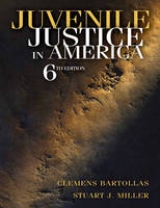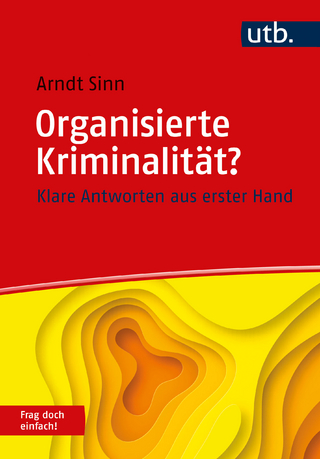
Juvenile Justice in America
Pearson (Verlag)
978-0-13-225694-0 (ISBN)
- Titel erscheint in neuer Auflage
- Artikel merken
Fully focused on the important issues, emerging trends, contemporary research, and special challenges facing juvenile justice today, this comprehensive exploration of the American juvenile justice system covers the history and philosophy of juvenile justice, the current practices for processing youthful offenders, the detention of juveniles, and the diversion of youth from the juvenile justice system. Unique in its approach, it gives students an “up-close and personal” view of the fascinating and sometimes tragic world of the juvenile offender–and the personal, psychological and thinking processes that characterize juvenile misbehavior.
CHAPTER 1: JUVENILE JUSTICE: AN OVERVIEW
How did Juvenile Justice Develop in the United States?
What Are the Historical Themes of Juvenile Justice?
What Are the Juvenile Justice Agencies and Functions?
How Are Juvenile Offenders Processed?
What Are the Most Widely Held Philosophies and Strategies on Correcting Juveniles?
CHAPTER 2: THE MEASUREMENT OF JUVENILE CRIME AND VICTIMIZATION
How and What Do We Know About Juveniles? The Measurement of Juvenile Crime
What Are Self-Report and Cohort Measures of Juvenile Crime?
What Are the Dimensions of Law-Violating Behaviors?
What Are the Backgrounds of Juvenile Victims?
CHAPTER 3: CAUSES OF JUVENILE CRIME
What Is the Relationship Between Theory and Research?
Is Juvenile Crime Rational Behavior?
How Has Determinism Influenced the Development of the Positive School?
How Does Integrated Theory Explain Juvenile Crime?
Why Has Delinquency Across the Life Course Become So Important?
Application of Theory to Practice
PART II: THE SYSTEM AND EARLY DECISION MAKING
CHAPTER 4: THE POLICE
What Is the History of Police-Juvenile Relations?
What are Juveniles’ Attitudes Toward the Police?
What is Police Discretion and How does it Affect the Police Response to Juveniles?
How Do Police Process Juveniles?
What Legal Rights Do Juveniles Have with the Police?
How Are Police Departments Organized to Fight Juvenile Crime?
How Is Community Oriented Policing Being Used to Tackle Problems in Today’s Communities?
CHAPTER 5: THE JUVENILE COURT
What Major Changes Have Occurred in the Juvenile Court?
How Have Legal Norms Changed?
How Is the Status Offender Controlled?
What Does the Juvenile Court Look Like Today?
What Are the Pretrial Procedures of the Juvenile Court?
CHAPTER 6: JUVENILE TRIAL AND DISPOSITION
What Are Other Stages of Juvenile Court Proceedings?
What Right Does the Child Have to Appeal?
What Is the Juvenile Sentencing Structure?
What Would Justice for Juveniles Look Like?
Toward Excellence in the Juvenile Delinquency Court
CHAPTER 7: JUVENILES IN ADULT COURT
Children or Adults?
How Does Transfer to Adult Court Take Place?
How Does a Youthful Offender System Work?
What Is Life Like for a Juvenile Sent to Prison?
The Juvenile Death Penalty: Three Decades of Change
A Proposed Adult Court for Juveniles
PART III: COMMUNITY-BASED CORRECTIONS
CHAPTER 8: JUVENILE PROBATION
How Is Probation Administered?
What Are the Functions of Probation Services?
How about Risk Control and Crime Reduction?
How Do Probation Officers Do Their Jobs?
What Are the Rights of Probationers?
What Is the Role of Volunteers in Probation?
Is Probation Effective?
CHAPTER 9: COMMUNITY-BASED PROGRAMS
What Has Been the Community’s Acceptance of Community-Based Programs?
How Are Community-Based Programs Administered?
What Is the Role of Delinquency Prevention?
What Is the Role of Diversion?
How do Day Treatment Programs Operate?
How Do Group Homes Operate?
What Are Wilderness Programs?
Are Community-Based Programs Effective?
PART IV: INSTITUTIONALIZATION
CHAPTER 10: JUVENILE INSTITUTIONALIZATION AND AFTERCARE
What Are the Short-Term Confinements of Juveniles?
What Are the Long-Term Confinements of Juveniles?
What Are the Troubling Aspects of Juvenile Institutionalization?
Do Institutionalized Youths Have Rights?
How does Juvenile Aftercare Operate?
CHAPTER 11: TREATMENT TECHNOLOGIES
What is the Treatment Debate?
How Are Youthful Offenders Classified?
What Are the Main Treatment Modalities?
Why Is Treatment Effectiveness So Difficult to Attain?
PART V: TOWARD AN UNDERSTANDING OF THE YOUTHFUL OFFENDER
CHAPTER 12: JUVENILE GANGS
How Have Gangs Evolved in the United States?
What Is Important to Know about Urban Street Gangs?
How Is Gang Involvement Toxic?
What Can Communities Do to Prevent and Control Youth Gangs?
CHAPTER 13: DRUGS AND YOUTHFUL OFFENDING
What Are the Main Types of Drugs?
How Much Drug Use Is There Among Juveniles?
What Is the Relationship between Drug Use and Delinquency?
What Categories Make Up Drug and Alcohol Users?
What About Drug Trafficking Juveniles?
What Explains the Onset of Drug Use?
CHAPTER 14: GENDER, RACE/ETHNICITY, AND CLASS
What Are Explanations of Female Crime?
What is s Feminist Theory of Delinquency?
What Are the Most Important Dimensions of Female Delinquent Behavior?
How Does Gender Bias Affect the Processing of the Female Delinquent?
What is the Influence of Class on the Handling of Juvenile Offenders?
What Is the Influence of Race on Juvenile Justice
PART VI: THE INTERNATIONAL SCENCE
CHAPTER 15: INTERNATIONAL JUVENILE JUSTICE
What Are the Beijing Rules?
How Do Industrialized Nations Handle Juvenile Crime?
How do Emerging Nations Handle Juvenile Crime?
PART VII: THE FUTURE
CHAPTER 16: JUVENILE JUSTICE IN THE TWENTY-FIRST CENTURY
How Do the Problems of Modern Society Affect Youths at Risk?
Why Is It Hard for a Juvenile Offender to “Go Straight”?
What Problems Are There in the Administration of Juvenile Justice?
What will Juvenile Justice Look Like in the Twenty-First Century?
What Is a Viable Credo for Juvenile Justice in the Next One Hundred Years?
| Erscheint lt. Verlag | 28.3.2007 |
|---|---|
| Sprache | englisch |
| Maße | 210 x 276 mm |
| Themenwelt | Recht / Steuern ► Allgemeines / Lexika |
| Recht / Steuern ► EU / Internationales Recht | |
| Recht / Steuern ► Strafrecht ► Kriminologie | |
| ISBN-10 | 0-13-225694-0 / 0132256940 |
| ISBN-13 | 978-0-13-225694-0 / 9780132256940 |
| Zustand | Neuware |
| Haben Sie eine Frage zum Produkt? |
aus dem Bereich



